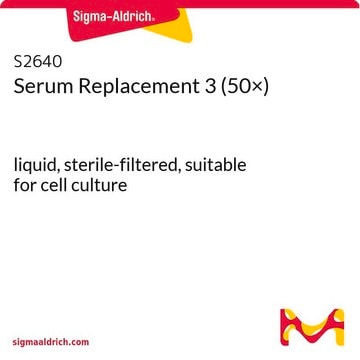Products may be shipped at a different temperature than the recommended long-term storage temperature. If the product quality is sensitive to short-term exposure to conditions other than the recommended long-term storage, it will be shipped on wet or dry-ice. If the product quality is NOT affected by short-term exposure to conditions other than the recommended long-term storage, it will be shipped at ambient temperature. As shipping routes are configured for minimum transit times, shipping at ambient temperature helps control shipping costs for our customers. For more information, please refer to the Storage and Transport Conditions document: https://www.sigmaaldrich.com/deepweb/assets/sigmaaldrich/marketing/global/documents/316/622/storage-transport-conditions-mk.pdf
Kluczowe dokumenty
746398
Sodium chloride
anhydrous, Redi-Dri™, free-flowing, ACS reagent, ≥99%
Synonim(y):
Halite, NaCl
About This Item
Polecane produkty
klasa czystości
ACS reagent
anhydrous
Poziom jakości
agency
suitable for GB 5009.253-2016
ciśnienie pary
1.33 hPa ( 865 °C)
linia produktu
Redi-Dri™
Próba
≥99%
Formularz
powder
jakość
free-flowing
zanieczyszczenia
≤0.005% Insoluble matter
pH
5.0-9.0 (25 °C, 5% in solution)
mp
801 °C (lit.)
ślady anionów
bromide (Br-): ≤0.01%
chlorate, nitrate (as NO3-): ≤0.003%
iodide (I-): ≤0.002%
phosphate (PO43-): ≤5 ppm
sulfate (SO42-): ≤0.004%
ślady kationów
Ba:, passes test
Ca: ≤0.002%
Fe: ≤2 ppm
K: ≤0.005%
Mg: ≤0.001%
heavy metals: ≤5 ppm (by ICP-OES)
ciąg SMILES
[Na+].[Cl-]
InChI
1S/ClH.Na/h1H;/q;+1/p-1
Klucz InChI
FAPWRFPIFSIZLT-UHFFFAOYSA-M
Szukasz podobnych produktów? Odwiedź Przewodnik dotyczący porównywania produktów
Powiązane kategorie
1 of 4
Ta pozycja | 793566 | S9888 | S6191 |
|---|---|---|---|
| assay ≥99% | assay ≥99% | assay ≥99.0% | assay ≥99% (titration) |
| Quality Level 100 | Quality Level 200 | Quality Level 200 | Quality Level 200 |
| grade ACS reagent, anhydrous | grade anhydrous | grade ACS reagent | grade BioPerformance Certified |
| anion traces bromide (Br-): ≤0.01%, iodide (I-): ≤0.002%, sulfate (SO42-): ≤0.004%, chlorate, nitrate (as NO3-): ≤0.003%, phosphate (PO43-): ≤5 ppm | anion traces - | anion traces bromide (Br-): ≤0.01%, chlorate, nitrate (as NO3-): ≤0.003%, iodide (I-): ≤0.002%, phosphate (PO43-): ≤5 ppm, sulfate (SO42-): ≤0.004% | anion traces - |
| cation traces Ba:, passes test, Fe: ≤2 ppm, Mg: ≤0.001%, K: ≤0.005%, Ca: ≤0.002%, heavy metals: ≤5 ppm (by ICP-OES) | cation traces - | cation traces Ba:, passes test, Ca: ≤0.002%, Fe: ≤2 ppm, K: ≤0.005%, Mg: ≤0.001%, heavy metals: ≤5 ppm (by ICP-OES) | cation traces ≤5 ppm (Heavy metals by ICP-OES) |
Opis ogólny
Zastosowanie
Cechy i korzyści
- Increased efficiency – Eliminate time and effort of loosening hardened powders
- Safety – Avoid risks of using tools of force to break up clumps
- Economy – Faster preparation and solvation increase productivity and reduce costs
- Assured quality – Excellent, expert-tested quality with no anti-caking agents
- Flexible volumes – Available from research amounts to scale-up quantities
Informacje prawne
Kod klasy składowania
13 - Non Combustible Solids
Klasa zagrożenia wodnego (WGK)
WGK 1
Temperatura zapłonu (°F)
Not applicable
Temperatura zapłonu (°C)
Not applicable
Wybierz jedną z najnowszych wersji:
Certyfikaty analizy (CoA)
Nie widzisz odpowiedniej wersji?
Jeśli potrzebujesz konkretnej wersji, możesz wyszukać konkretny certyfikat według numeru partii lub serii.
Masz już ten produkt?
Dokumenty związane z niedawno zakupionymi produktami zostały zamieszczone w Bibliotece dokumentów.
Klienci oglądali również te produkty
Produkty
Redi-Dri™ zapobiega wchłanianiu wilgoci i tworzeniu się grudek przez higroskopijne proszki, takie jak sole nieorganiczne, pozostawiając za każdym razem sypkie sole.
Redi-Dri™ prevents hygroscopic powders, such as inorganic salts, from absorbing moisture and forming clumps, leaving the salts free-flowing every time.
Protokoły
Overcoated SPME fiber enables low-level BPA analysis in food via SPME-GC-MS/MS, meeting tighter migration limit regulations.
-
How is shipping temperature determined? And how is it related to the product storage temperature?
1 answer-
Helpful?
-
-
How can I determine the shelf life / expiration / retest date of this product?
1 answer-
If this product has an expiration or retest date, it will be shown on the Certificate of Analysis (COA, CofA). If there is no retest or expiration date listed on the product's COA, we do not have suitable stability data to determine a shelf life. For these products, the only date on the COA will be the release date; a retest, expiration, or use-by-date will not be displayed.
For all products, we recommend handling per defined conditions as printed in our product literature and website product descriptions. We recommend that products should be routinely inspected by customers to ensure they perform as expected.
For products without retest or expiration dates, our standard warranty of 1 year from the date of shipment is applicable.
For more information, please refer to the Product Dating Information document: https://www.sigmaaldrich.com/deepweb/assets/sigmaaldrich/marketing/global/documents/449/386/product-dating-information-mk.pdfHelpful?
-
-
How long will material remain free-flowing after it is opened?
1 answer-
While the exact amount of time your material will remain free-flowing can vary, this largely depends on the ambient storage conditions and how many times it is opened.
Helpful?
-
-
How does Redi-Dri™ help keep salts and buffers free-flowing?
1 answer-
Redi-Dri™ products are specially handled and the bottle is specially designed to ensure that the product will remain dry without adding impurities or additives to the product. Ensuring that you receive the highest quality material that is easy to handle.
Helpful?
-
-
Are there any special storage conditions that must be maintained?
1 answer-
No, Redi-Dri™ products can be stored under the same conditions as the equivalent non-Redi-Dri™ products.
Helpful?
-
Active Filters
Nasz zespół naukowców ma doświadczenie we wszystkich obszarach badań, w tym w naukach przyrodniczych, materiałoznawstwie, syntezie chemicznej, chromatografii, analityce i wielu innych dziedzinach.
Skontaktuj się z zespołem ds. pomocy technicznej




